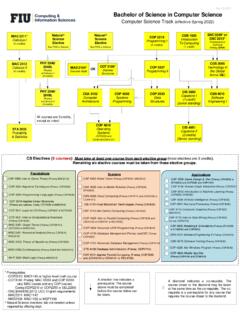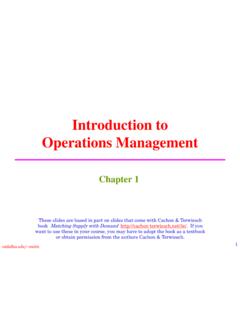Transcription of Introduction to Weed Science and Weed Identification
1 Introduction to Weed Science and Weed Identification Definition of a Weed A plant growing where it is not wanted (Oxford Dictionary). Any plant or vegetation, excluding fungi, interfering with the objectives or requirements of people (European Weed Science Society). A plant that is especially successful at colonizing and proliferating in disturbed sites First Steps in Weed Management To effectively manage weeds you should know: What weed you are dealing with . correct Identification Consider impact of the weed Life cycle of the weed Weed biology influences methods and optimum time for management strategies Weed Classification Morphology Structure and form Life cycle How it develops Yellow foxtail Ground ivy Yellow nutsedge Weed Classification Morphology Monocotyledon one cotyledon or one embryonic leaf Grasses, sedges, rushes Dicotyledon - two cotyledons Broadleaf plants Weed Classification Life Cycle Annuals Complete their life cycle from seed to seed in less than 12 months Velvetleaf Giant foxtail Cocklebur Summer Annuals Seeds germinate in spring Flower in mid to late summer Produce seed in late summer or fall, then die Lambsquarters Similar growing season to Large crabgrass corn and soybean , lambsquarters, foxtails, crabgrass, purslane, waterhemp Winter Annuals Pennycress Germinate in late summer or fall Dormant over winter Flower and produce seed in mid to late spring Die in summer , shepherd's purse, chickweed, pennycress.
2 Speedwells Chickweed Biennials Complete life cycle in two years Germinate and form basal rosette first year, remain vegetative and Musk thistle store food for winter Wild carrot Wild parsnip Biennials Flower, produce seed, and die during second growing season Need undisturbed soil for at least two years Musk thistle , musk thistle, wild carrot, wild parsnip, garlic mustard Wild carrot Wild parsnip Perennials (herbaceous). Live for more than two years Simple: produce a taproot, spread only by seed , Dandelion, broadleaf Broadleaf plantain plantain Creeping: can reproduce by buds, rhizomes, tubers, bulbs, and seed , Quackgrass, nutsedge, Yellow nutsedge leafy spurge Weed ID - Sources of Information ISU Weed Identification Field Guide Reference books Extension bulletins Many websites Someone in the know . Local experts Extension offices What Makes a Weed Successful? Seed characteristics Ability to germinate and grow in many environments Rapid seedling growth Prostrate spurge Self-compatibility or easy cross-pollination Vigorous vegetative reproduction Ability to tolerate environmental stresses Canada thistle Seed Characteristics Giant ragweed Longevity of seed Long period of seed production High seed output Ability to produce seed in adverse conditions Long and short seed dispersal Lambsquarters Vegetative Reproduction Rhizomes Underground structures that produce new plants , canada thistle, quackgrass Stolons Quackgrass Above-ground creeping stems that root at nodes and produce new plants , ground ivy (creeping charlie) Ground ivy Vegetative Reproduction Bulbs, bulblets, tubers Underground leaf tissue modified for food storage.
3 Produces new plants , wild garlic, yellow Yellow nutsedge nutsedge Aerial bulblets (above ground). , wild onion, wild garlic Wild onion Vegetative Reproduction Plant reproduction Each plant part can regenerate another plant Asiatic dayflower When cultivating, the implement can redistribute them in the field , Asiatic dayflower, purslane Purslane Dispersal Wind Attachment burs, thorns, stickers Birds digestion/excretion Dandelion Artificial dispersal human dispersal . Soil and compost Equipment Plants Contaminated seed Burdock Weed Management Strategies Canada thistle Velvetleaf Poison ivy Yellow nutsedge Summary Identify the weed Know the life cycle Use control strategies based on weed species, life cycle, crop, field or landscape situation, and the environment





